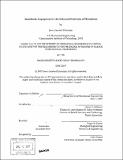| dc.contributor.advisor | Elazer R. Edelman. | en_US |
| dc.contributor.author | Echenique, Javier Jacobo | en_US |
| dc.contributor.other | Massachusetts Institute of Technology. Dept. of Mechanical Engineering. | en_US |
| dc.date.accessioned | 2008-01-10T15:50:52Z | |
| dc.date.available | 2008-01-10T15:50:52Z | |
| dc.date.copyright | 2007 | en_US |
| dc.date.issued | 2007 | en_US |
| dc.identifier.uri | http://hdl.handle.net/1721.1/39880 | |
| dc.description | Thesis (S.M.)--Massachusetts Institute of Technology, Dept. of Mechanical Engineering, 2007. | en_US |
| dc.description | Includes bibliographical references (leaves 111-114). | en_US |
| dc.description.abstract | Controlled thrombosis initiates and regulates tissue repair and remodeling in the vessel wall. Processes from heart attack to stroke, and deep vein thrombosis to pulmonary embolism, are all derived from unrestricted clotting. The frustrating aspects of these diseases lie not only in the difficulty of their timely diagnosis, but in the selection of appropriate therapy, titration of intervention, and identification of patients at risk. Assays like the INR, PTT, and ACT can follow the course of specific pathways that govern activation of specific coagulation factors or platelet function, but they do not provide the insight into mechanism, risk and potential therapeutic benefit. We posit that elucidation of the complex dynamics of clot generation requires an integrated assessment that takes into account all of the factors driving thrombosis simultaneously. Virchow's Triad, has for years been identified as the three critical parameters of clot formation. We propose to examine an individual's clot propensity and response to therapy on minute blood samples, in virtual real time, across a range of flow rates, blood state, and wall conditions with the use of our newly developed in vitro high-throughput testing device. | en_US |
| dc.description.abstract | (cont.) In this manner we will generate a unique thrombotic fingerprint that defines an individual's risk of clotting at a specific point in time over a range of stresses. This fingerprint can aid in tailoring therapeutic clinical treatments, determining the duration and dose of therapy, and assist in clinical trial management and establishment of clinical norms. | en_US |
| dc.description.statementofresponsibility | by Javier Jacobo Echenique. | en_US |
| dc.format.extent | 137 leaves | en_US |
| dc.language.iso | eng | en_US |
| dc.publisher | Massachusetts Institute of Technology | en_US |
| dc.rights | M.I.T. theses are protected by copyright. They may be viewed from this source for any purpose, but reproduction or distribution in any format is prohibited without written permission. See provided URL for inquiries about permission. | en_US |
| dc.rights.uri | http://dspace.mit.edu/handle/1721.1/7582 | |
| dc.subject | Mechanical Engineering. | en_US |
| dc.title | Thrombotic fingerprints for the enhanced prediction of thrombosis | en_US |
| dc.type | Thesis | en_US |
| dc.description.degree | S.M. | en_US |
| dc.contributor.department | Massachusetts Institute of Technology. Department of Mechanical Engineering | |
| dc.identifier.oclc | 182522882 | en_US |
